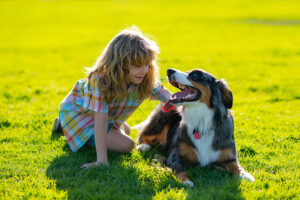There is plenty of truth to the maxim that a dog is “man’s best friend,” but like any friendship, the relationship between people and dogs is not one that should be taken for granted – especially when children are involved. Estimates by the Centers for Disease Control and Prevention (CDC) place the number of pet dogs in the United States at around 68 million, and while many of these are well-behaved dogs who will never have an incident of aggressive or dangerous behavior, the same cannot be said of all dogs. More than 1 million dog bite incidents are reported each year, and some estimates suggest that an equal number of incidents take place but are not reported. Alarmingly, about 3 out of 5 of reported dog bite incidents result in injury to a child. Both parents and dog owners benefit from learning about the factors that influence dog bite injuries to children and how to prevent them.
 First, it’s helpful to understand what the “typical” dog bite accident involving children looks like. Children most likely to suffer a dog bite are those between the ages of 5 and 9. In about 70 percent of dog bite injuries to children are inflicted on the face – which both underscores the danger posed to children and suggests that part the reason for many dog bite incidents is that the dog feels threatened. While it’s important for parents to teach children to be cautious around strange dogs and never to touch or pet an unknown dog without the dog owner’s approval, strange dogs account for a minority of reported dog bite incidents. Over 60 percent of bite attacks take place in the dog owner’s home, and in more than three-quarters of cases, the bite victim is a family member or a close friend of someone in the dog owner’s family, and thus in most cases have some familiarity with the animal.
First, it’s helpful to understand what the “typical” dog bite accident involving children looks like. Children most likely to suffer a dog bite are those between the ages of 5 and 9. In about 70 percent of dog bite injuries to children are inflicted on the face – which both underscores the danger posed to children and suggests that part the reason for many dog bite incidents is that the dog feels threatened. While it’s important for parents to teach children to be cautious around strange dogs and never to touch or pet an unknown dog without the dog owner’s approval, strange dogs account for a minority of reported dog bite incidents. Over 60 percent of bite attacks take place in the dog owner’s home, and in more than three-quarters of cases, the bite victim is a family member or a close friend of someone in the dog owner’s family, and thus in most cases have some familiarity with the animal.
Whether due to past experiences or media portrayals, many people believe that some breeds of dog are inherently aggressive or dangerous or assume that other breeds are innately safe and good with children. While there are some inherited tendencies common among certain breeds, most experts agree there is no such thing as a universally “child-safe” or “vicious” breed. Much like humans, dogs have personalities that are strongly influenced by socialization, training, environment, and experience, and these play a primary role in determining whether a dog is likely to bite in a given circumstance. While it’s true that larger breeds have the physical strength to inflict more damage with a bite, smaller dogs can be just as aggressive while appearing cute and non-threatening. Breed alone is never a reliable indicator of whether a dog is safe or dangerous.
For dog owners, one of the most important steps in making your dog safe and comfortable around children is early socialization, when the dog is still a puppy. Children can be loud, fast-moving, and not always careful around pets, so a dog unfamiliar with child behavior may become anxious and aggressive. Giving a dog early exposure to children in its first two or three months of life helps to normalize their behavior for the dog, reducing the likelihood that it will develop a tendency to bite children. For male dogs, neutering can also reduce aggressive tendencies. (Of course, there are many other reasons that make it a good idea to spay and neuter pets in addition to curbing future behavioral problems.) Whenever possible, the dog should be introduced to children of different ages and personalities, a loud toddler and a shy preteen present very different stimuli and challenges for a dog.
When dogs and children live in the same household, both need to be taught how to behave around each other. Children should take part in the dog’s regular training sessions as well as the everyday care responsibilities of the dog; this helps the dog perceive the child as an authority figure instead of an equal and encourages the child to be responsible and considerate of the dog. Children should also be taught to recognize and understand a dog’s body language cues, so they know when the dog feels threatened, afraid, or aggressive. This way, the child can avoid close contact with the dog or alter their behavior to put the dog at ease, which may help them avoid a bite incident. In addition, it’s important that parents and other adults in the child’s life model good behavior around dogs. Kids tend to emulate the actions and attitude of their adult role models, and a child who observes their parents treating the family dog with authoritative, consistent, and gentle behavior will be more likely to act appropriately toward not only that dog, but others that the child may encounter, which can reduce their risk of dog bites.
If a child is injured by a dog bite, remember that under New Jersey law, a dog owner is strictly responsible for that bite and the damages flowing from it – including medical bills and compensation for pain, suffering, and scarring. An exception exists, saving the owner from legal responsibility if the dog was being taunted, which is only natural. If you believe your child should be compensated due to a dog bite, talk to an experienced injury attorney about the law and your options.
Contact MyNJInjuryLawyer Howard P. Lesnik
If you or a loved one suffered a dog bite injury in NJ, you should contact an attorney familiar with handling these claims. An experienced NJ Injury Lawyer will know how to obtain medical records, videos, photographs, experts, locate witnesses and contact the insurance company so you can make a claim for your injuries.
My NJ Injury Lawyer Howard P. Lesnik, Esq. offers complimentary strategy sessions to address any issue or questions you may have for your injury claim in NJ.
Please contact NJ Injury Lawyer Howard Lesnik, Esq., immediately if you were involved in a dog bite. I personally handle NJ injury cases on a regular basis. Please contact me now by email, by phoning 908.264.7701, or by completing the form to the right to schedule your complimentary 30-minute strategy session. Call me direct and I will answer 5 questions that you have about your potential claim.







